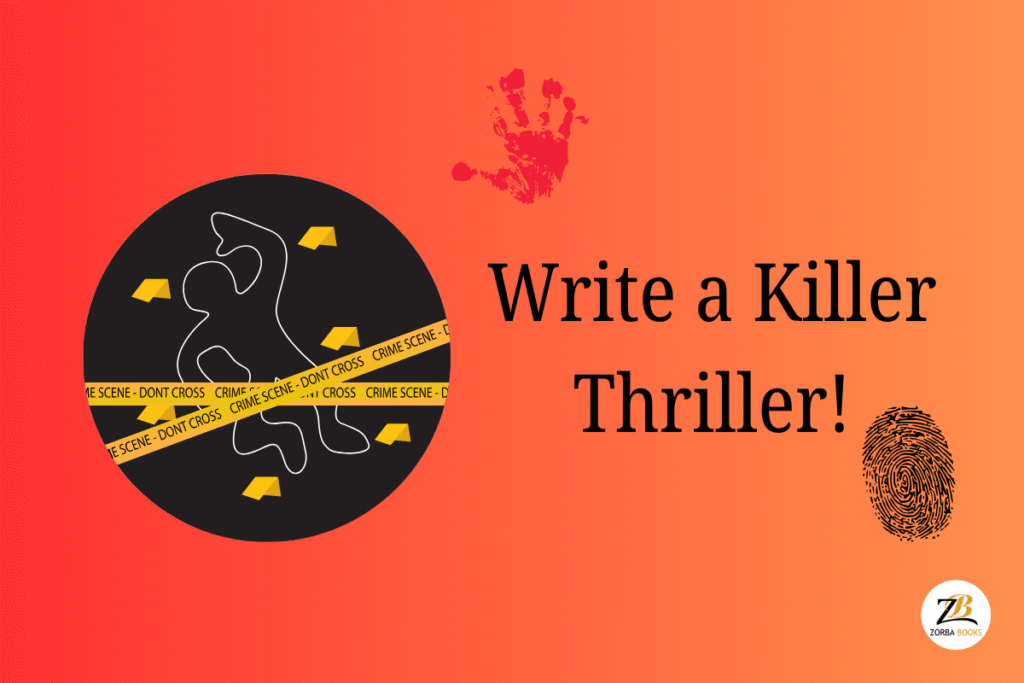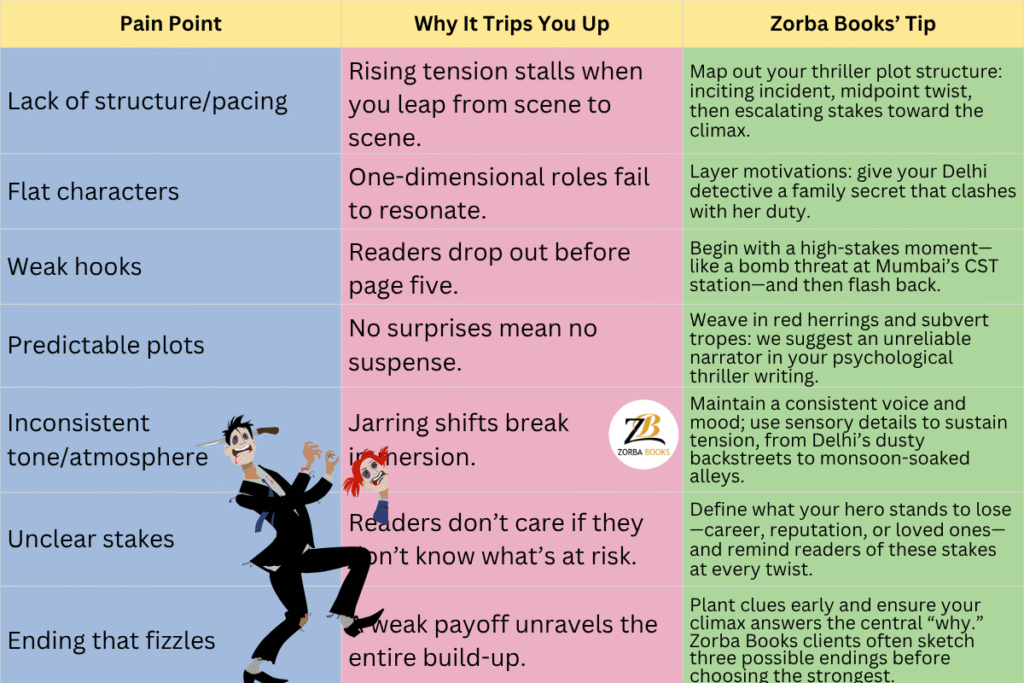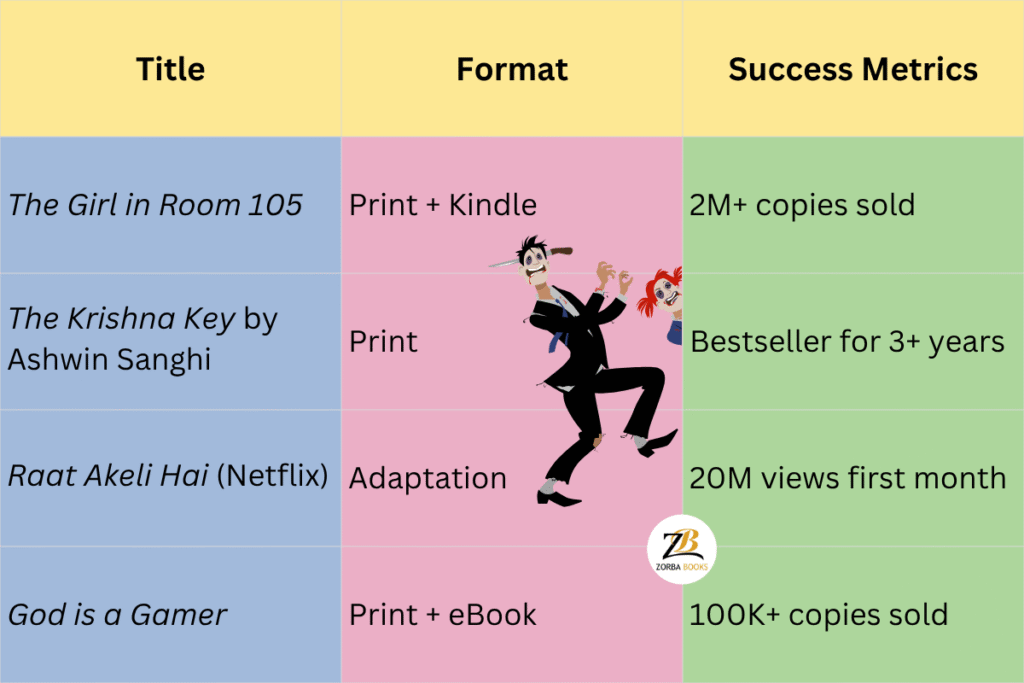
Master the Art of Suspense and Achieve Successful Book Publication
At Zorba Books, we know every aspiring writer dreams of crafting a nail-biting thriller that keeps readers turning pages late into the night. But rookie authors often stumble over pacing, character depth, and plot twists. In his guide, we share implementable tips—backed by real examples—to help you master suspense writing techniques, thriller plot structure, and psychological thriller writing. Ready to transform your manuscript into a heart-pounding page-turner? Let’s dive in and explore how to write a thriller.
- Why Thrillers Sell
- Your Roadmap to Success: Top Pain Points & Quick Fixes
- Mastering Plot & Pacing: The Build-Up to Writing a Thriller
- Crafting Complex Characters while Writing a Thriller
- Crafting Unpredictable Twists
- Setting & Atmosphere: Your Secret Weapon to Writing a Thriller
- Creating Tension in Dialogue
- Delivering a Satisfying Climax & Resolution
- Bestselling Indian Thrillers
- Thriller Writing Toolkit
1. Why Thrillers Sell—and Why Yours Will Too
Thrillers consistently rank among India’s top-selling genres. According to industry reports, crime and suspense novels saw a 20% rise in sales across urban centers like Mumbai and Delhi between 2019 and 2024, thanks to platforms like Kindle and Audible. Readers crave high-stakes drama, complex characters, and unexpected twists. By leveraging proven thriller writing tips and a clear suspense arc, you can tap into a market hungry for more pulse-quickening reads.
Thrillers are among the top three fiction and non fiction genres consumed by Indian readers, alongside romance and mythology.
With shows based on books like Sacred Games, criminal Justice drawing huge audiences, Indian readers are now hungry for the next great thriller in book in English, Hindi or regional language format.
We have seen a 20% rise in thriller submissions since 2022 from aspiring authors hoping to reach a wider audience.
2. Your Roadmap to Success: Top Pain Points & Quick Fixes
Here’s a snapshot of the most common rookie mistakes in writing a thriller and Zorba Books’ go-to solutions for writers:

3. Mastering Plot & Pacing: The Build-Up to Writing a Thriller
1. “Is My Plot Strong or Just Predictable?”
It was found that readers abandon a thriller if:
- The twist is obvious
- The characters are flat
- The plot doesn’t build suspense
Start with a compelling “What if?”
➡ What if a woman suspects her husband’s death was staged?
➡ What if a small-town cop uncovers a crime linked to a corporate empire?
2. “I’m Struggling With Pacing — Too Slow, Too Fast!”
Data from Storytel India shows:
- Thriller audiobooks with slow starts have 42% higher drop-off rates
- Books with chapters under 5 pages see 25% more completions
A thriller’s heartbeat is its pacing. Without a solid thriller plot structure, even the best hooks fizzle. Zorba Books advises mapping out three key milestones:

You can refine pacing with short chapters or cliffhanger endings; these are powerful suspense writing techniques that keep readers hungry for “just one more chapter.”
Well-paced thrillers are more likely to be picked up by book publishing houses and included in major publishing group catalogues.
4. Crafting Complex Characters while Writing a Thriller
A thriller’s impact hinges on character development. Flat protagonists and villains make your plot meaningless—no one cares who wins. In psychological thriller writing, you must deepen motivations and moral conflicts. Use character arcs, dual loyalties, and shades of grey to make heroes and antagonists unforgettable.
a) I Can’t Write Believable Villains
Villains make or break thrillers. Today’s readers want nuance. According to a Writers’ Digest study, thrillers with complex villains are twice as likely to become bestselling authors’ picks.
Think of Guruji in Sacred Games or Ganesh Gaitonde. They’re haunting, human, and unforgettable.
5. Crafting Unpredictable Twists
Plot twists are the lifeblood of thrillers, but they must feel earned. The worst sin is a shock that comes out of nowhere. Instead, shadow your red herrings with subtle clues—an overheard snippet, a stray thread in a government file, or a hidden letter in Mumbai’s bylanes. Zorba Books suggests balancing misdirection with payoff: ensure every twist echoes earlier setups, so readers can revisit clues and marvel at your narrative craft.
a. My Twists Feel Forced or Unrealistic
Twists must be earned—not thrown in for shock value. Our editors have observed that over 60% of rejected manuscripts lack a coherent setup for their final twist.
Use:
- Background cues
- Minor character hints
- Unreliable narrators sparingly
A satisfying twist is one where the reader gasps—but then nods and says, “Of course!”
6. Setting & Atmosphere: Your Secret Weapon to Writing a Thriller
Your environment can amplify suspense. Think beyond “dark alley” and embrace location-specific details—be it Chennai’s salt-scorched coast under a blood-red sunset or the narrow lanes of Jaipur’s Old City at dusk. Every creaking stair, honking auto-rickshaw, or distant temple bell can ratchet up tension. When you weave setting seamlessly into your storyline, it becomes a tool that heightens each twist and keeps the readers on edge.
a. How Do I Create Suspense and Mood?
Setting is essential. A foggy Delhi night. A decaying Kolkata mansion. A rainy hill station in Ooty. Mood builds emotion.
In a reader poll, the atmosphere stayed with a reader long after finishing a thriller.
- Use short, sensory-rich descriptions.
- Contrast silence and noise.
- Insert urgency into setting transitions.
Think of setting not as a background, but a trigger for suspense.
b. Hook Them from Page One
First impressions are everything. In thriller writing for beginners, you need an opening scene that screams urgency. We recommend starting right in the middle of the action. Picture this: a lone commuter races through Mumbai’s monsoon-soaked platform, a stranger in pursuit, the screech of an incoming train echoing ominously.
By opening with a high-tension scenario, you use suspense writing techniques that stick with the reader’s emotions. Sprinkle in sensory details—rain slapping your character’s face, neon lights reflected in puddles—to set the mood and establish your thriller’s tone from word one.
7. While Writing a Thriller Create Tension in Dialogue
Dialogue in thrillers isn’t small talk—it’s a weapon. Every line should reveal character, create tension, or advance the plot. Avoid info-dump conversations; instead, use clipped sentences, unfinished threats, and loaded pauses. For instance, in a Jaipur night market scene, your hero corners a suspect—each question is a test of nerves, each response laden with subtext.
8. Delivering a Satisfying Climax & Resolution
Your climax must feel inevitable yet surprising. All your suspense arcs, character dilemmas, and environmental details converge in one electrifying sequence—perhaps a rooftop chase through Delhi’s skyline at dawn or a final confrontation in Mumbai’s abandoned textile mill. A strong resolution cements your reputation and primes your audience for the next book.
9. Learn From These Bestselling Indian Thrillers

Many of these started as books in English and went on to become bestselling authors—with a few even adapted for screen.
10. Thriller Writing Toolkit (Zorba Edition)
| Element | Why It Matters |
| Hook | Creates the opening tension |
| Conflict | Drives the protagonist |
| Villain | Adds weight and stakes |
| Structure | Keeps the reader glued |
| Setting | Enhances suspense |
| Dialogue | Reveals more than it says |
| Twist | Surprise + satisfaction |
Share This With a Fellow Writer!
Know someone working on a crime novel or suspense story?
Share this blog with them on WhatsApp, LinkedIn, or your writing group. Help more authors break into the thriller genre with confidence.
Zorba Books is proud to support independent publishers, open access thinkers, and India’s next generation of bestselling authors.
Contact us today at www.zorbabooks.com
Email: info@zorbabooks.com
Discover more from ZorbaBooks
Subscribe to get the latest posts sent to your email.